Shea (Vitellaria paradoxa) Butter Production and Resource Use by Urban and Rural Processors in Northern Ghana
Abstract
:1. Introduction
2. Literature Review
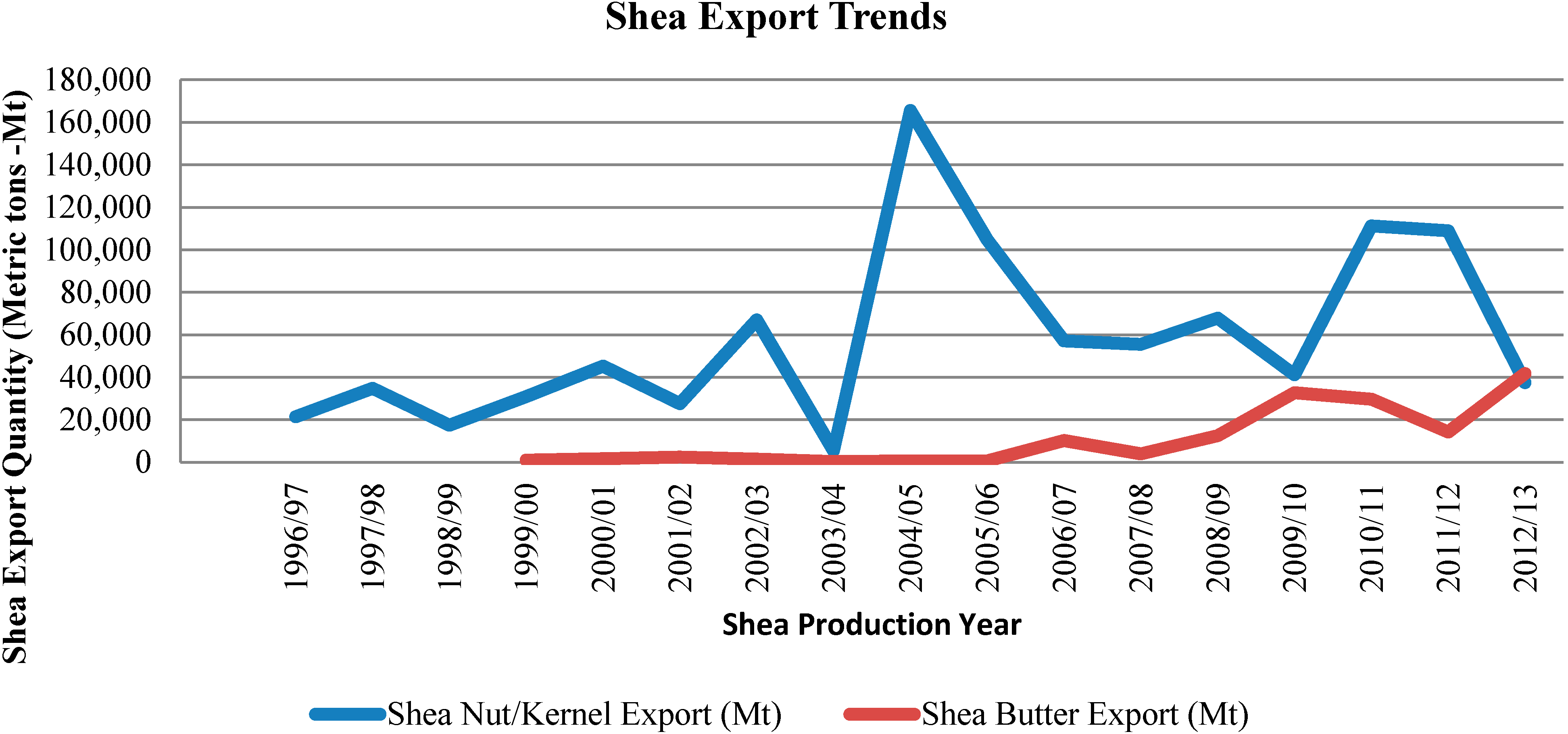
3. Materials and Methods
3.1. MFA and Shea Production Process

3.2. Study Sites
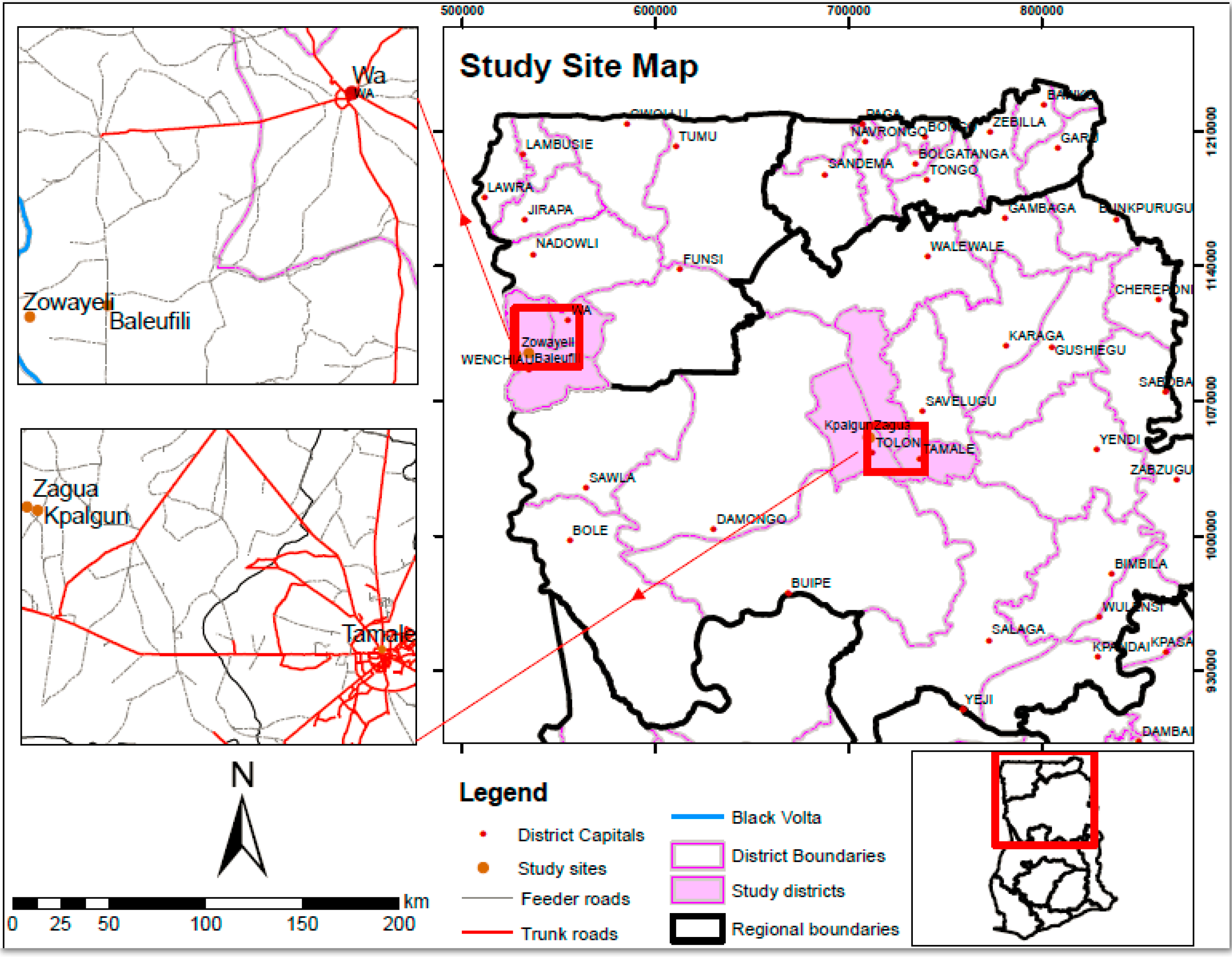
3.3. Procedure for Experiment (Production Process)
| Region | Northern Region | Upper West Region | ||||||
|---|---|---|---|---|---|---|---|---|
| Setting | Rural | Urban | Rural | Urban | ||||
| Experiment site | Kpalgun | Zagua | Tamale-Tiyumba | Tamale-Tiehisuma | Baleufili | Zowayeli | Wa-Kpaguri | Wa-Mangu |
| Equipment used at least a big bowl (basin) and a bucket were used in all processing stages at all locations | ||||||||
| Crushing/Breaking of nuts stage | ||||||||
| Mortar and pestle | ✔ | ✔ | ✔ | ✔ | ✔ | |||
| Electric Crusher | ✔ | ✔ | ✔ | |||||
| Roasting of grits stage | ||||||||
| Roaster stove | ✔ | ✔ | ||||||
| Frying pan | ✔ | ✔ | ✔ | ✔ | ||||
| Cooking pot | ✔ | ✔ | ||||||
| Three stone stove | ✔ | ✔ | ✔ | ✔ | ✔ | ✔ | ||
| Milling of grits stage | ||||||||
| Milling stone | ✔ | ✔ | ✔ | ✔ | ||||
| Milling Machine | ✔ | ✔ | ✔ | ✔ | ||||
| Cooking/heating of crude butter stage | ||||||||
| Three stone open stove | ✔ | ✔ | ✔ | ✔ | ✔ | ✔ | ✔ | ✔ |
| Wooden stirrer | ✔ | ✔ | ✔ | ✔ | ✔ | ✔ | ✔ | ✔ |
| Number of participants | 4 adults | 4 adults | 4 adults | 5 adults | 3 adults | 3 adults | 4 adults | 4 adults |
| Gender | Females | Females | Females | Females | Females | Females | Females | Females |
| Processing techniques | Non mechanized | Non mechanized | Partly mechanized | Partly mechanized | Non mechanized | Non mechanized | Partly mechanized | Partly mechanized |
| Target market | Community and nearby retail market | Community and nearby retail market | Export and Cosmetic industry | Export and Cosmetic industry | Community and nearby retail market | Community and nearby retail market | Urban retail market and bulkers | Urban retail market and bulkers |
4. Results and Discussion
4.1. Shea Butter Processing Conditions in the Experiment Sites
4.2. Input inventory and Material Quantity Accounting
| Region | Northern Region | Upper West Region | |||||||
|---|---|---|---|---|---|---|---|---|---|
| Setting Experiment site | Rural | Urban | Rural | Urban | |||||
| Kpalgun | Zagua | Tamale-Tiyumba | Tamale-Tiehisuma | Baleufili | Zowayeli | Wa-Kpaguri | Wa-Mangu | ||
| Stages/Direct Material Inputs | |||||||||
| 01 | Sorting and Cleaning | ||||||||
| Water (L) | 50 | 55 | 25 | 40 | 40 | ||||
| Labor (man-hours) | 02:00 | 01:40 | 01:20 | 01:00 | 01:12 | 01:18 | 01:13 | 01:10 | |
| Shade-Drying (man-hours) | 03:00 | 02:50 | 02:15 | 02:20 | 02:17 | ||||
| 02 | Crushing/Breaking | ||||||||
| Labor in man-hours | 03:00 | 02:52 | 00:34 | 00:32 | 01:52 | 02:00 | 00:24 | 01:58 | |
| 03 | Roasting | ||||||||
| Fuel wood (kg) | 23.00 | 25.00 | 15.00 | 14.60 | 21.00 | 20.00 | 18.00 | 17.50 | |
| Dry kernel waste (kg) | 1.50 | 1.8 | 3.0 | 4.0 | 2.2 | 1.5 | 3.0 | 4.0 | |
| Labor (man-hours) | 02:12 | 02:05 | 01:34 | 01:30 | 01:50 | 01:56 | 01:34 | 01:43 | |
| 04 | Pounding and Milling/Grinding grits into paste | ||||||||
| Labor using grinding stone (man-hours) | 03:35 | 03:34 | 03:00 | 02:48 | |||||
| Labor using milling machine | 00:32 | 00:31 | 00:27 | 00:30 | |||||
| 05 | Kneading/Beating | ||||||||
| Water (L) | 142 | 145 | 150 | 165 | 115 | 110 | 125 | 122 | |
| Labor (man-hours) | 02:25 | 02:30 | 02:20 | 02:23 | 02:00 | 02:05 | 01:50 | 01:58 | |
| Fuel wood to heat water (kg) | 3.0 | 3.2 | 2.8 | 2.8 | 2.0 | 2.2 | 2.5 | 2.2 | |
| 06 | Boiling/Cooking of emulsion | ||||||||
| Fuel wood (kg) | 36.0 | 35.0 | 37.0 | 32.0 | 30.0 | 29.0 | 27.0 | 25.0 | |
| Dry kernel waste (kg) | 3.0 | 3.4 | 5.5 | 6.0 | 2.2 | 1.5 | 2.5 | 3.0 | |
| Labor (man-hours) | 02:00 | 02:10 | 01:40 | 01:52 | 01:30 | 01:22 | 01:25 | 01:20 | |
| Cooling overnight (man-hours) | 12:00 | 12:00 | 12:00 | 12:00 | 12:00 | 12:00 | 12:00 | 12:00 | |
| Water at packaging (L) | 22 | 20 | 12 | 16 | 17 | 10 | 13 | 15 | |
| 07 | Direct Material Output | ||||||||
| Shea butter output (kg) | 34.0 | 33.0 | 38.0 | 40.0 | 29.0 | 28.0 | 31.0 | 32.0 | |
| Wastewater (L) | 114 | 102 | 180 | 187 | 125 | 92 | 138 | 125 | |
| Solid residue (kg) | 8.0 | 8.0 | 5.0 | 5.0 | 10.0 | 10.0 | 6.0 | 6.0 | |
4.2.1. Sorting and Cleaning
4.2.2. Crushing/Breaking of Raw Kernel
4.2.3. Roasting of Raw Kernel Grits
4.2.4. Milling Roasted Grits into Paste
4.2.5. Kneading
4.2.6. Heating of Crude Butter and Solidification
4.3. Resource Consumption and Output
4.3.1. Water
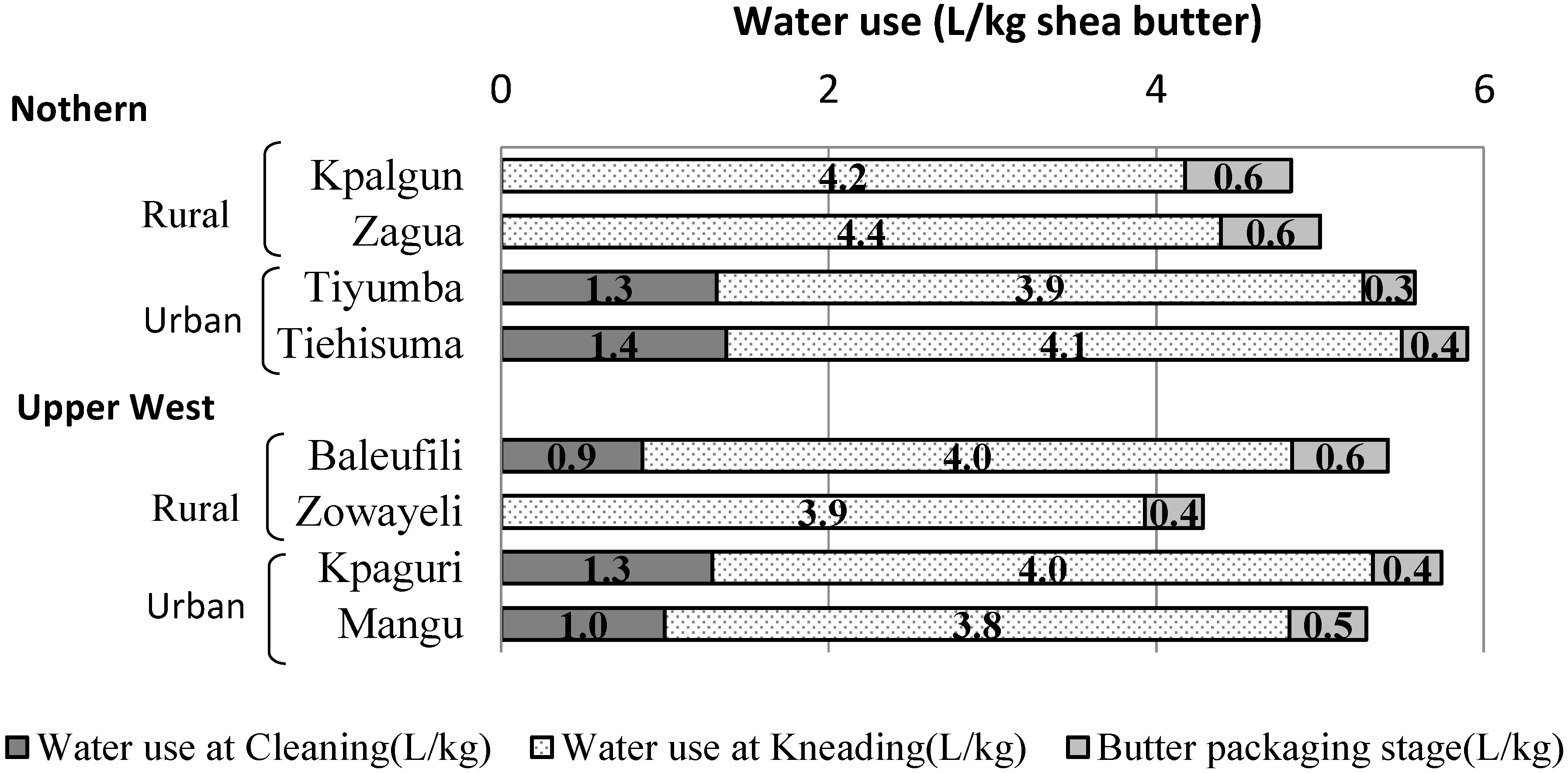
4.3.2. Energy
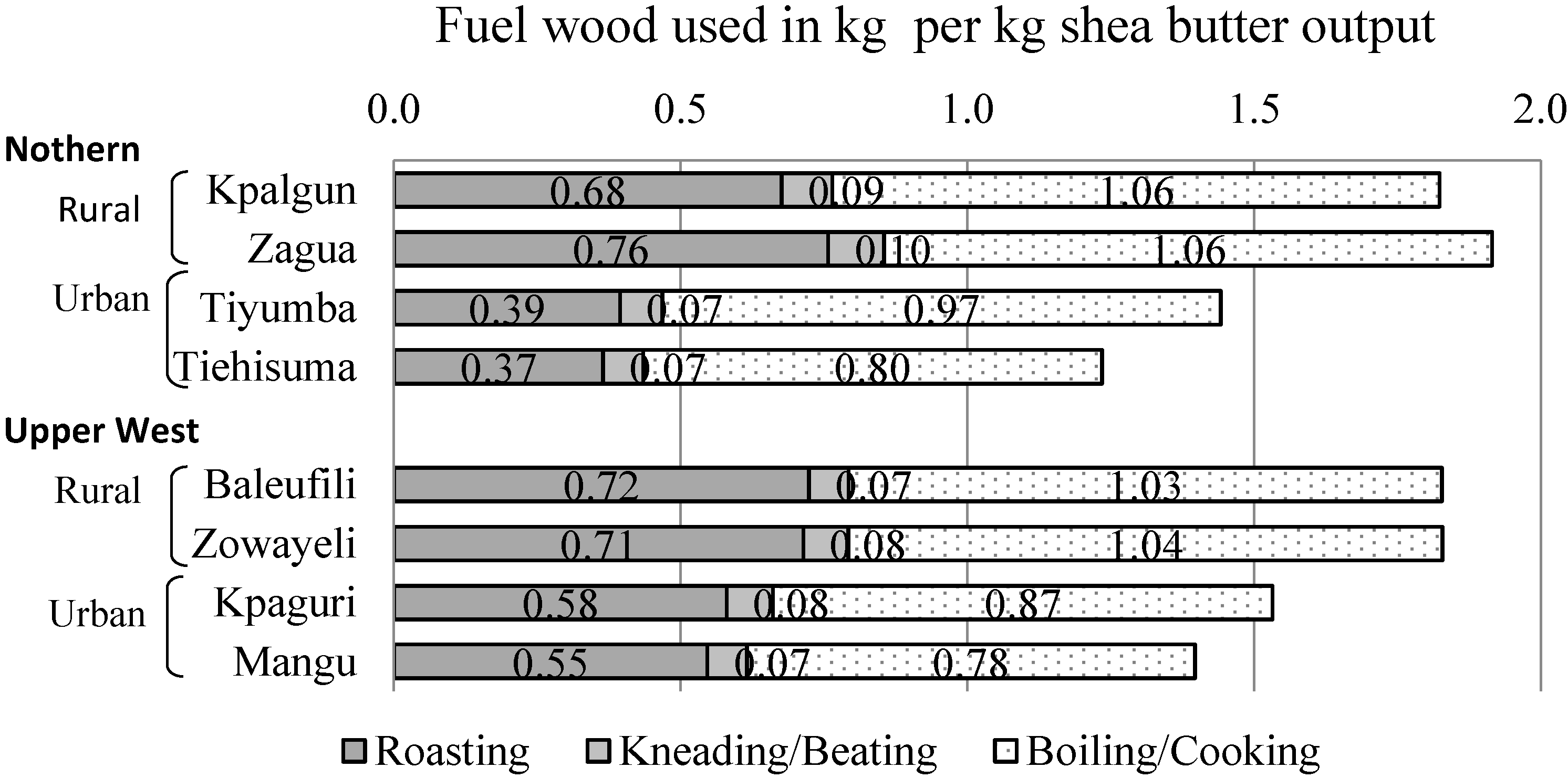

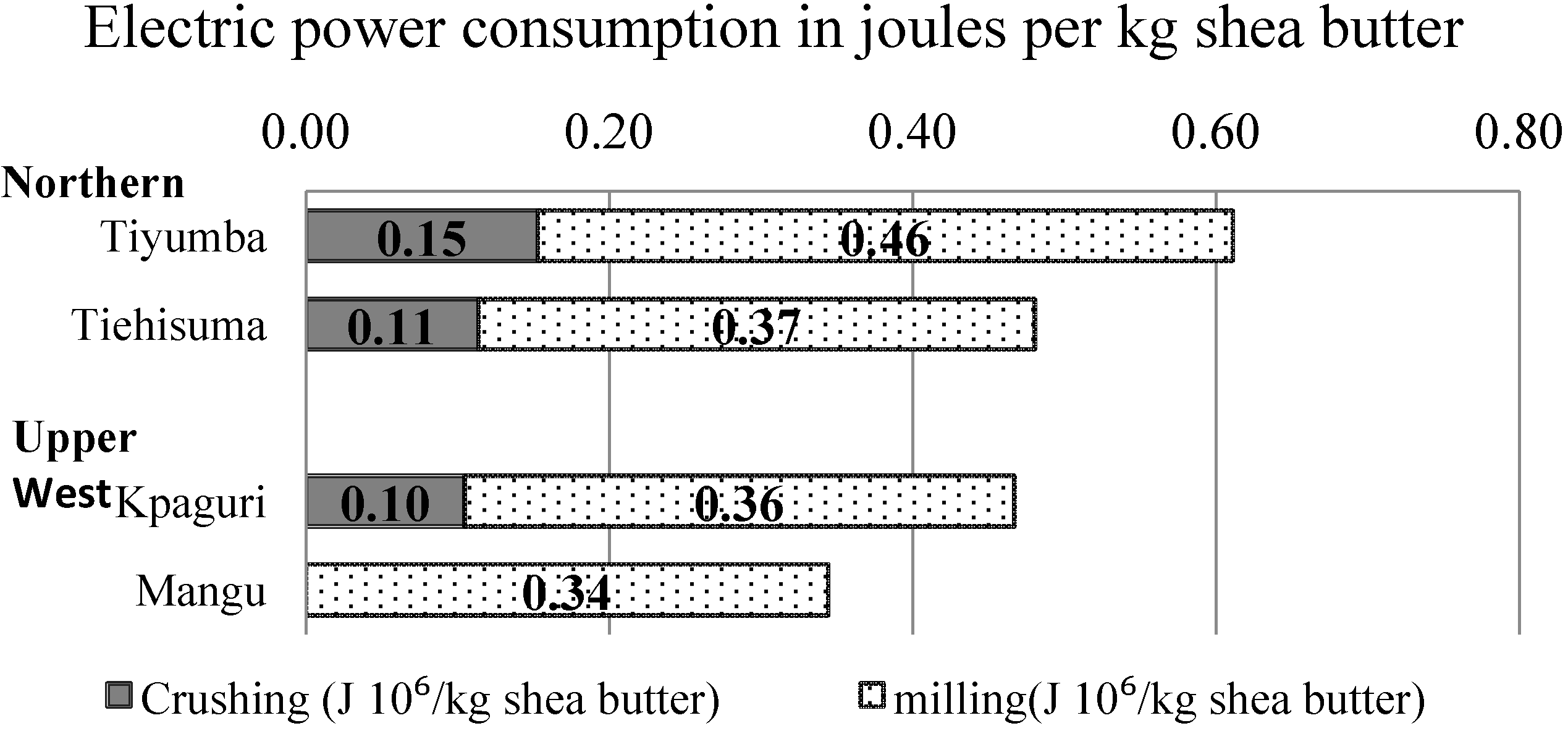
4.3.3. Labor
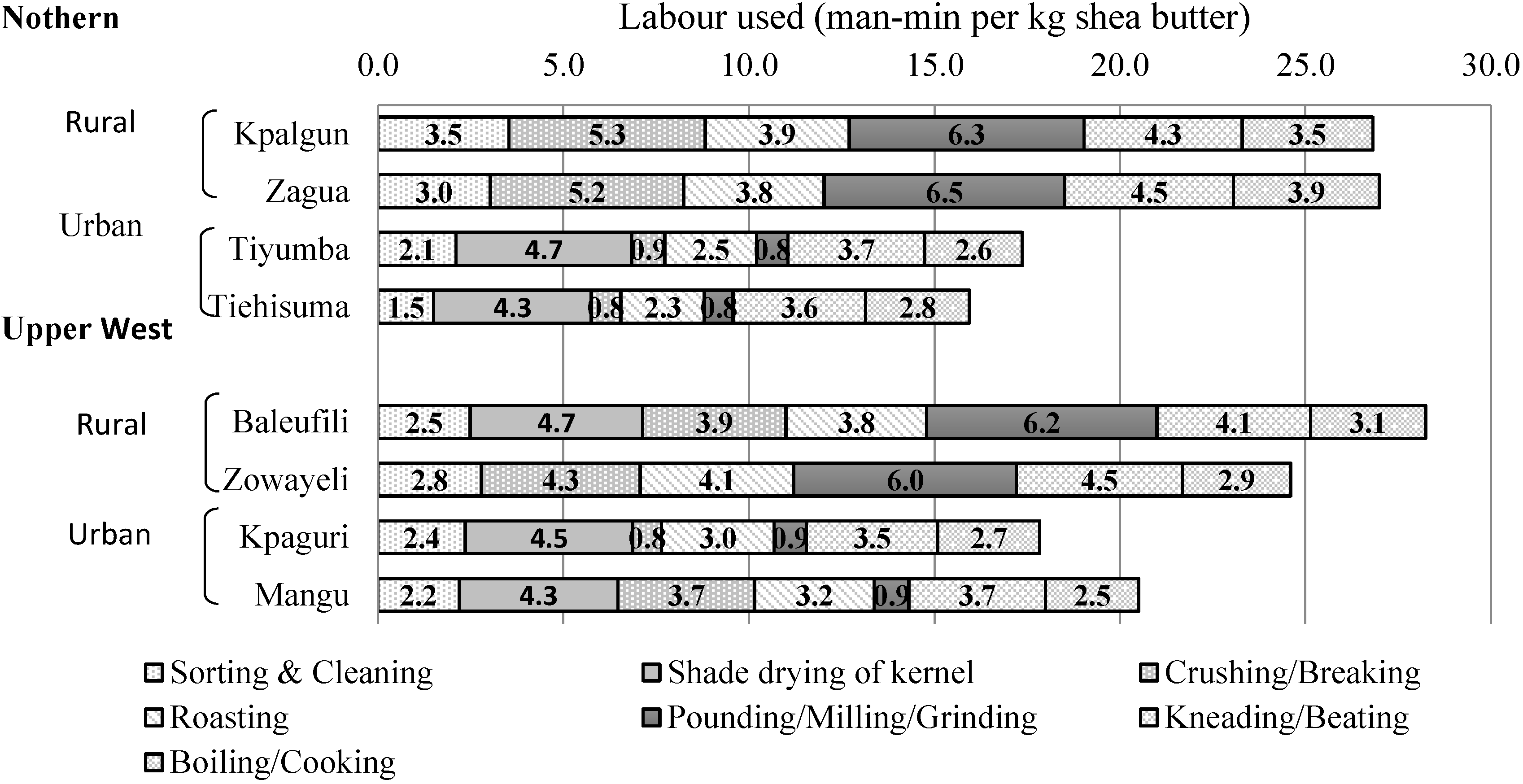
4.4. Resource Use Linkages and Shea Butter Output Quality
5. Summary and Conclusions
Acknowledgments
Author Contributions
Conflicts of Interest
References
- Shackleton, C.M.; Shackleton, S.E. The importance of non-timber forest products in rural livelihood security and as safety nets: A review of evidence from South Africa. South Afr. J. Sci. 2004, 100, 658–664. [Google Scholar]
- Ros-Tonen, M.A.F.; Wiersum, K.F. The scope of improving rural livelihoods through Non-Timber Forest Products: An evolving research agenda. For. Trees Livelihoods 2005, 15, 129–148. [Google Scholar] [CrossRef]
- Ahenkan, A.; Boon, E. Commercialization of non-timber forest products in Ghana: Processing, packaging and marketing. Food Agric. Environ. 2010, 8, 962–969. [Google Scholar]
- Shackleton, C.M.; Pandey, A.K. Positioning Non-Timber Forest Products on the Development Agenda. For. Policy Econ. 2014, 38, 1–7. [Google Scholar] [CrossRef]
- Belcher, B.; Schreckenberg, K. Commercialisation of non-timber forest products: A reality check. Dev. Policy Rev. 2007, 25, 355–377. [Google Scholar] [CrossRef]
- Wunder, S.; Angelsen, A.; Belcher, B. Forests, Livelihoods, and Conservation: Broadening the Empirical Base. World Dev. 2014, 64, S1–S11. [Google Scholar] [CrossRef] [Green Version]
- Kusakari, Y.; Asubonteng, K.O.; Jasaw, G.S.; Dayour, F.; Dzivenu, T.; Lolig, V.; Donkoh, S.; Obeng, F.; Gandaa, B.; Kranjac-Berisavljevic, G. Farmers’ Perceived Effects of Climate Change on Livelihoods in Wa West District, Upper West Region of Ghana. J. Disaster Res. 2014, 9, 516–528. [Google Scholar]
- Lovett, P.N. The Shea Butter Value Chain: Production, Transformation and Marketing in West Africa; West Africa Trade Hub (WATH): Accra, Ghana, 2004. [Google Scholar]
- Danida Forest Seed Centre (DFSC). Vitellaria paradoxa Gaertn. f. Seed Leaflet. Available online: http://sl.ku.dk/rapporter/seed-leaflets/filer/vitellaria-paradoxa-50.pdf (accessed on 24 March 2015).
- Lovett, P.N.; Haq, N. Evidence for anthropic selection of the Sheanut tree (Vitellaria paradoxa). Agrofor. Syst. 2000, 48, 273–288. [Google Scholar] [CrossRef]
- Hatskevich, A.; Jeníček, V.; Antwi Darkwah, S. Shea Industry—A Means Of Poverty Reduction In Northern Ghana. Agric. Trop. Et Subtrop. 2011, 44, 223–228. [Google Scholar]
- Dogbevi, E.K. Shea Nut has Economic and Environmental Values for Ghana; Sekaf Ghana Ltd.: Tamale, Ghana, 2009. [Google Scholar]
- Pouliot, M. Contribution of “Women’s Gold” to West African livelihoods: The case of shea (Vitellaria paradoxa) in Burkina Faso. Econ. Bot. 2012, 66, 237–248. [Google Scholar] [CrossRef]
- Elias, M.; Carney, J.A. African Shea Butter: A Feminized Subsidy from Nature, Africa. J. Int. Afr. Inst. 2007, 77, 37–62. [Google Scholar] [CrossRef]
- Boffa, J.M. Agroforestry Parkland Systems in Sub-Saharan Africa; Food and Agriculture Organization of the United Nations: Rome, Italy, 1999. [Google Scholar]
- Asante, W.J.; Banidiyia, M.A.; Tom-Dery, D. Effect of planting depth on the germination and initial growthand development of shea (Vitellaria paradoxa C.F. Gaertn.). Int. J. Biosci. (IJB) 2012, 2, 146–152. [Google Scholar]
- GEPA (Ghana Export Promotion Authority). Shea production and export trends. 2014; unpublished work. [Google Scholar]
- Stichting Nederlandse Vrijwilligers (SNV). Improving Market Access for Smallholder Farmers: Concept Note on Developing Shea Market Chains; SNV Shea Subsector Study: Tamale, Ghana, 2006. [Google Scholar]
- Addaquay, J. The Shea Butter Value Chain, Refining in West Africa; West Africa Trade Hub (WATH): Accra, Ghana, 2004. [Google Scholar]
- Seidu, A. Market Access Capacity of Women Shea Processors in Ghana. Available online: http://journal.ucc.edu.gh/index.php?journal=jass&page=article&op=view&path%5B%5D=5 (accessed on 24 March 2015).
- Cocoa Research Institute of Ghana (CRIG). Research and development of the Shea tree and its products. Available online: http://www.solutions-site.org/cat11_sol119.htm (accessed on 21 September 2014).
- Issahaku, H.; Al-Hassan, R.; Daniel, B.S. An analysis of allocative efficiency of shea butter processing methods in the northern region of Ghana. J. Dev. Agric. Econ. 2011, 3, 165–173. [Google Scholar]
- Glew, D.; Lovett, P.N. Life cycle analysis of shea butter use in cosmetics: From parklands to product, low carbon opportunities. J. Cleaner Prod. 2014, 68, 73–80. [Google Scholar] [CrossRef]
- Jasaw, G.S.; Boafo, Y.A.; Lolig, V. Factors Influencing the Adoption of Mucuna Pruriens as a Land Conservation Strategy, Evidence From Northern Ghana. J. Sci. Technol. Environ. 2014, 4, 1–11. [Google Scholar]
- Boafo, Y.A.; Saito, O.; Takeuchi, K. Provisioning ecosystem services in rural savanna landscapes of northern Ghana: An assessment of supply, utilization and drivers of change. J. Disaster Res. 2014, 9, 501–515. [Google Scholar]
- Clark, G.; Jasaw, G.S. Evaluating team project-work using triangulation:lessons from communities in northern Ghana. J. Geogr. Higher Educ. 2014, 38, 511–524. [Google Scholar] [CrossRef]
- Carette, C.; Malotaux, M.; van Leeuwen, M.; Tolkamp, M. Sheanut and Butter in Ghana. Opportunities and Constraints for Local Processing; University of Wageningen: Wageningen, The Netherlands, 2009. [Google Scholar]
- Tsuda, K.; Hara, K.; Uwasu, M. Prospects and Challenges for Disseminating Life Cycle Thinking towards Environmental Conscious Behaviors in Daily Lives. Sustainability 2013, 5, 123–135. [Google Scholar] [CrossRef]
- Rodríguez, M.T.; Andrade, L.C.; Bugallo, P.M.; Long, J.J. Combining LCT tools for the optimization of an industrial process: material and energy flow analysis and best available techniques. J. Hazard Mater 2011, 193, 1705–1719. [Google Scholar] [CrossRef]
- OECD. Measuring Sustainable Development: Report of the Joint Working Party on Statistics for Sustainable Development; OECD: Paris, France, 2008. [Google Scholar]
- Bringezu, S. International symposium‚ Industrial ecology and sustainability. In Industrial Ecology and Material Flow Analysis; Technical University of Troyes: Troyes, France, 2000. [Google Scholar]
- Burström, F. Materials Accounting and Environmental Management in Municipalities. J. Environ. Assess. Policy Manag. 2000, 1, 297–327. [Google Scholar] [CrossRef]
- Wang, P.-C.; Lee, Y.-M.; Chen, C.-Y. Estimation of Resource Productivity and Efficiency: An Extended Evaluation of Sustainability Related to Material Flow. Sustainability 2014, 6, 6070–6087. [Google Scholar] [CrossRef]
- Fischer-Kowalski, M. Society’s Metabolism—The Intellectual History of Material Flow Analysis, Part I: 1860–1970. J. Ind. Ecol. 1998, 2, 61–78. [Google Scholar] [CrossRef]
- Bringezu, S.; Stiller, A.H.; Schmidt-Bleek, F. Material Intensity Analysis—A screening Step for LCA, Concept, method and applications. In Proceedings of the Second International Conference on EcoBalance, Tsukuba, Japan, 18–20 November 1996; pp. 147–152.
- Bringezu, S. From Quantity to Quality: Materials Flow Analysis. In Proceedings of the ConAccount Workshop, Leiden, The Netherlands, 21–23 January 1997; pp. 43–57.
- Bringezu, S. Accounting for the Physical Basis of National Economies: Material Flow Indicators—Sustainability Indicators; Eurostat: Laxembourg, 1997; pp. 170–180. [Google Scholar]
- Bovenkerk, M. The Use of Material Flow Accounting in Environmental Policy Making in the Netherlands. In Proceedings of the ConAccount Conference, Wuppertal, Germany, 11–12 September 1997; Wuppertal Institute: Wuppertal, Germany, 1997; pp. 28–37. [Google Scholar]
- Van der Voet, E. Substances from Cradle to Grave. Development of a Methodology for the Analysis of Substances Flows Through the Economy and the Environment of a Region. With Case Studies on Cadmium and Nitrogen Compounds. Ph.D. Thesis, Leiden University, Leiden, 1996. [Google Scholar]
- Udo de Haes, H.; Van der Voet, E.; Kleijn, R. Substance Flow Analysis (SFA) an analytical tool for integrated chain management. In Regional and National Material Flow Accounting: From Paradigm to Practice of Sustainability; Wuppertal Institute: Wuppertal, The Netherlands, 1997. [Google Scholar]
- Allenby, B.R. Industrial Ecology-Policy Framework and Implementation; Prentice Hall: Upper Saddle River, NJ, USA, 1999. [Google Scholar]
- Boffa, J.M.; Yaméogo, G.; Nikiéma, P.; Knudson, D.M. Shea Nut (Viterallia paradoxa) Production and Collection in Agroforestry Parklands of Burkina Faso, Proceedings of International Conference on Domestication and Commercialization of Non-Timber Forest Products, Nairobi, Kenya, 19–23 February 1996; FAO: Rome, Italy, 1991.
- Savanna Agricultural Research Unit (SARI). Agro Meteorological Unit; SARI: Tamale, Ghana, 2001. [Google Scholar]
- Saito, O. Resource Use and Waste Generation by the Tourism Industry on the Big Island of Hawaii. J. Ind. Ecol. 2013. [Google Scholar] [CrossRef]
- Collins, A.M.; Suleman, D.; Ricky, Y.N. Urban Poverty in Northern Ghana: Tracing the Livelihood Strategies of Women in the Shea Butter Industry. J. Human Soc. Sci. Res. 2014, 3, 15–25. [Google Scholar]
© 2015 by the authors; licensee MDPI, Basel, Switzerland. This article is an open access article distributed under the terms and conditions of the Creative Commons Attribution license (http://creativecommons.org/licenses/by/4.0/).
Share and Cite
Jasaw, G.S.; Saito, O.; Takeuchi, K. Shea (Vitellaria paradoxa) Butter Production and Resource Use by Urban and Rural Processors in Northern Ghana. Sustainability 2015, 7, 3592-3614. https://doi.org/10.3390/su7043592
Jasaw GS, Saito O, Takeuchi K. Shea (Vitellaria paradoxa) Butter Production and Resource Use by Urban and Rural Processors in Northern Ghana. Sustainability. 2015; 7(4):3592-3614. https://doi.org/10.3390/su7043592
Chicago/Turabian StyleJasaw, Godfred Seidu, Osamu Saito, and Kazuhiko Takeuchi. 2015. "Shea (Vitellaria paradoxa) Butter Production and Resource Use by Urban and Rural Processors in Northern Ghana" Sustainability 7, no. 4: 3592-3614. https://doi.org/10.3390/su7043592







